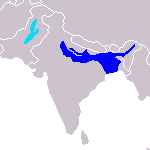Ganges dolphin
| Ganges dolphin | ||||||||||||
|---|---|---|---|---|---|---|---|---|---|---|---|---|

Ganges dolphin ( Platanista gangetica ) |
||||||||||||
| Systematics | ||||||||||||
|
||||||||||||
| Scientific name | ||||||||||||
| Platanista gangetica | ||||||||||||
| ( Roxburgh , 1801) |
The Ganges dolphin ( Platanista gangetica ) is a very rare toothed whale species that is endemic to the Ganges , Brahmaputra , Meghna, and Karnaphuli in northern India and Bangladesh . The total population is estimated at a few 100 to a few 1000 specimens, which today mainly live in the common delta of Ganges and Brahmaputra as well as in the lower Sangu in Bangladesh. The distribution area has shrunk considerably since the 19th century. The species is almost extinct in Nepal.
features
The Ganges dolphin is a maximum of 2.6 meters long and can weigh over 108 kg. Females are larger and have a longer snout. The head profile is steep and rounded due to the eye-catching melon . On the melon there is an elongated, uneven comb, at the rear end of which lies the elongated, slit-like blowhole . The eyes above the corners of the mouth are barely developed and tiny. The snout is flattened, gavial-like long and very slender. The front, bulbous, thickened part is covered with numerous, elongated and sharp teeth that remain visible even when the mouth is closed. The neck of the animals is unusually flexible and movable for whales. The back is flat and wide. On its rear section lies the flat, triangular fin , which ends in a low ridge that extends down to the broad fluke . The fluke is concave at the back and has long, pointed ends. The flippers are wide and paddle-like. Their rear edges are flat or wavy, creating a finger-like impression.
Ganges dolphins are colored olive yellow, olive brown, gray brown or gray blue. The ventral side is lighter, often pink. Young animals are colored uniformly gray.
The animals feed on fish and shrimp and can live to be at least 28 years old.
Surface behavior
The Ganges dolphin lives in small groups, alone or in pairs. He usually swims slowly and rarely jumps. However, jumps are noticeable due to the loud splash. The fluke is rarely visible. Dives last between 30 seconds and several minutes. He is shy of people.
Reproduction
Females become sexually mature with a length of two meters, males with a length of 1.7 meters. The gestation period is about a year. Newborns are 65 to 90 cm long and weigh about 6.5 kg. They start eating solid foods at one to two months of age, but are not weaned until they are almost a year old.
Systematics
The Indus dolphin was originally assigned to the Ganges dolphin as a subspecies, which does not differ externally from the Ganges dolphin. Today, however, it is listed as a separate species in the Mammal Species of the World database .
literature
- Hadoram Shirihai : marine mammals. All 129 species worldwide. Illustrated by Brett Jarett. Franckh-Kosmos Verlags GmbH, Stuttgart 2008, ISBN 978-3-440-11277-9 .
Web links
- Don E. Wilson & DeeAnn M. Reeder (Eds.): Platanista gangetica in Mammal Species of the World. A Taxonomic and Geographic Reference (3rd ed).
- Platanista gangetica inthe IUCN 2013 Red List of Threatened Species . Posted by: Smith, BD & Braulik, GT, 2008. Retrieved December 29, 2013.
